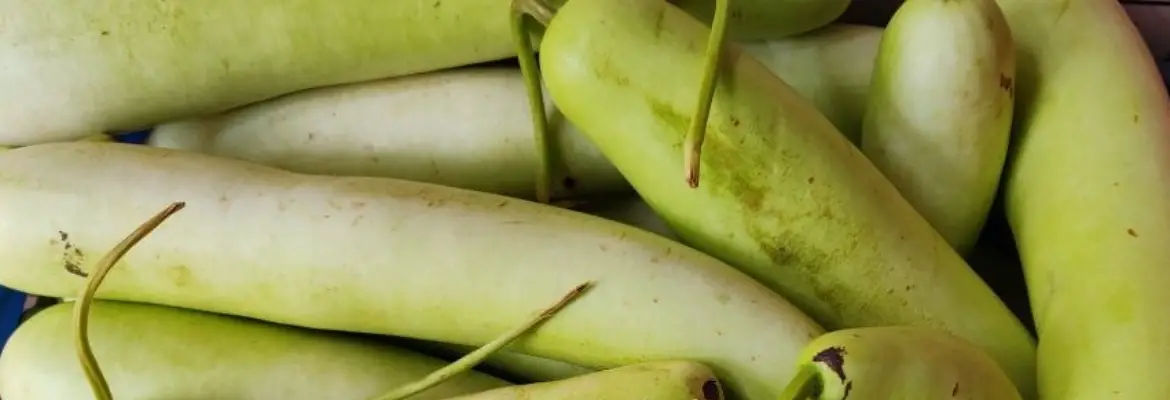Botanically a member of the Cucurbitaceae family, the bottle gourd is a part of a vine called Lagenaria siceraria. Bottle gourds have a rich history and were some of the first cultivated plants in history. Today, it is known by several different names in different parts of the world, including the names Opo, Calabash, Long Melon and Cucuzza.
You can find bottle gourds in a variety of shapes and sizes, depending on how you grow them and when you harvest them. Depending on the structure, it can be round or long and thin, curved or bulbous, or short and round.
Though most of its varieties have smooth skin, there are a few varieties with fine hairs. Its color can range from light green to chartreuse to dark green.
The flesh inside the bottle gourd is creamy white and has small seeds. Bottle gourd seeds are tender and edible when young, but become hard when more mature, and should be removed before eating.
With a firm texture and mild flavor, the young bottle gourd squash has a resemblance to summer squash and cucumbers.

Low in calories, bottle gourds contain small amounts of vitamin C, folate, calcium, iron, zinc, and B vitamins. It’s also high in fiber, which helps promote a healthy digestive system.
Vitamin C and zinc content as well as its ability to possibly regulate blood sugar levels are among the benefits of Bottle gourd juice.
Although, care should be exercised not to consume any bottle gourd juice that has developed a bitter taste, as this may contain toxins that may cause ulcers, serious damage to the digestive system, and even death in some cases.
Scientific name of Indian Squash / Bottle Gourd
Lagenaria Siceraria
Other names of Indian Squash / Bottle Gourd
- White-flowered gourd
- Calabash Gourd
- Opo Squash
- Long Melon
- Lauki
- Ghia
Calories by source in Indian Squash / Bottle Gourd
- Calories by carbohydrate in Indian Squash / Bottle Gourd = 88%
- Calories by fat in Indian Squash / Bottle Gourd = 1%
- Calories by protein in Indian Squash / Bottle Gourd = 11%
Fats and Fatty Acid profile of Indian Squash / Bottle Gourd
- Polyunsaturated fat (PUFA) in Indian Squash / Bottle Gourd = 60%
- Saturated fat (SFA) in Indian Squash / Bottle Gourd = 13%
- Monounsaturated fat (MUFA) in Indian Squash / Bottle Gourd = 27%
Nutrition facts of Indian Squash / Bottle Gourd
*Serving size = 100 grams = 3.55 Ounces = 1/2 cup
*DV= % Daily Value (%DV indicates how much nutrients contribute to a person’s daily diet from a serving of a food. DV assists you in determining whether or not a serving of food is high or low in a particular nutrient.)
| Nutrient | Amount | Unit |
|---|---|---|
| Calories | 14 | KCAL |
| Fat | 0.02 | GRAM |
| Protein | 0.62 | GRAM |
| Carbohydrate | 3.39 | GRAM |
| Fiber | 0.5 | GRAM |
Detailed vitamin profile of Indian Squash / Bottle Gourd, vitamin A, vitamin B12, vitamin B6, vitamin C, vitamin D, Folate, Niacin, Thiamin, and Riboflavin is shown in the chart.
Detailed mineral profile of Indian Squash / Bottle Gourd, Sodium(Na), Calcium(Ca), Copper(Cu), Iron(Fe), Magnesium(Mg), Selenium(Se), Phosphorus(P), Potassium(K) and Zinc(Zn) is shown the chart.
Availability of Indian Squash / Bottle Gourd
- Indian squash / bottle gourd is available round the year
Complete nutrition facts of Indian Squash / Bottle Gourd
Click on the link HERE to download high quality, high resolution and print ready PDF version of the Indian Squash / Bottle Gourd nutrition chart/infographic.



